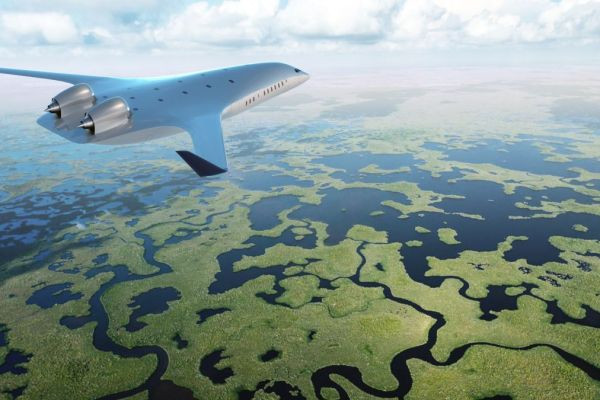In the last 60 years, not much has changed in terms of the fundamental design of commercial aircraft. The Douglas DC-8 and the Boeing 707, which were constructed in the late 1950s and established the "tube and wing" form factor that is still in use today, share a general design with contemporary aircraft like the Boeing 787 and the Airbus A350.
This is because the old design is still relevant due to other changes, such as those in materials and engines, and because commercial aviation prioritises safety by favouring tried-and-true solutions.
But since it has been so difficult to abandon its basic technologies, the industry has a somewhat more difficult struggle than other sectors as it desperately searches for ways to cut carbon emissions. It could be a good idea to give something new a shot.
Among the suggestions is the "blended wing body." The "flying wing" form utilised by military aircraft, such the recognisable B-2 bomber, is reminiscent of this completely new aircraft shape; nevertheless, the blended wing has more volume in the central region. The idea is being tweaked by Boeing, Airbus, and JetZero, a California-based company that has set an ambitious aim of putting a blended wing aircraft into service as early as 2030.
Tom O'Leary, co-founder and CEO of JetZero, states, "We feel very strongly about a path to zero emissions in big jets, and the blended wing airframe can deliver 50% lower fuel burn and emissions." "What the industry is used to pales in comparison to that incredible leap forward."
Under pressure
The idea of blended wings is not new; in fact, the first attempts to construct aircraft using this design were made in Germany in the late 1920s. In 1947, American industrialist and aircraft designer Jack Northrop designed a flying wing powered by jet engines, which served as the model for the B-2 in the 1990s.
The blended wing, which functions as a hybrid between a flying wing and a conventional "tube and wing," maximises lift production throughout the aircraft while reducing drag. According to NASA, this design "creates larger payload (cargo or passenger) areas in the aircraft's centre body portion and helps to increase fuel economy." Using the X-48, one of its experimental aircraft, the CIA has tested it.
Between 2007 and 2012, two unmanned, remote-controlled X-48s proved the concept's feasibility with around 120 test flights. According to the agency, "an aircraft of this type would have a wingspan slightly greater than a Boeing 747 and could operate from existing airport terminals." It would also be less expensive to operate and weigh less than an equally advanced conventional transport aircraft.
In 2020, Airbus constructed a small, roughly six-foot-long blended wing demonstrator to show that it was considering building a full-size aircraft in the future. But why haven't we started using the form to construct planes yet, given how successful it is?
One major technological obstacle, in O'Leary's opinion, is preventing manufacturers from progressing. "It's the pressurisation of a non-cylindrical fuselage," he explains, citing the fact that a plane with a tube form can withstand the continuous cycles of expansion and contraction that accompany every trip.
The pressurisation load is on the tube, and the bending loads are on the wings. This arrangement of "tube and wing" separates the loads. However, a composite wing combines those in essence. We can only accomplish that now that we have composite materials that are robust and light.
The inside of the plane would appear and feel very different from that of modern widebody aircraft due to its drastically altered shape. O'Leary explains, "It's just a much, much wider fuselage." This plane is designed like a shorter, broader tube than a standard single-aisle aircraft, which has seats arranged three by three. You get the same number of passengers, but the arrangement within the cabin may vary from airline to airline, with rows spanning 15 or 20.
They now have an entirely new colour scheme to work with when laying things out. I believe it will be fascinating to observe how they understand this much larger space.
Revolutionary potential
According to O'Leary, the closest size equivalent is the Boeing 767, a widebody, twin-engine aircraft that was first deployed in the 1980s and could accommodate up to 210 passengers. Although it is still manufactured as a freight airliner, the Boeing 787 has taken its place as a passenger aircraft. The US Air Force employs the KC-46, a more recent military version of it, for aerial refuelling.
Similar to this, JetZero plans to concurrently create three versions: a fuel tanker, a passenger plane, and a cargo plane. The latter is made possible by the blended wing shape so effectively that JetZero was recently granted $235 million by the US Air Force to create a full-scale demonstrator and verify the blended wing concept's performance. With a first flight anticipated by 2027, the military version of the aircraft is planned to set the standard and possibly even aid in the development of the commercial counterparts.
But creating a brand-new aircraft from the ground up is a huge undertaking, and JetZero's goals seem lofty considering that it can take years to fully certify even a modified version of an already-built aircraft. One advantage JetZero has in this regard is that the aircraft will initially use engines from current narrowbody aircraft, such as the Boeing 737; however, the ultimate goal is to switch to entirely emission-free propulsion powered by hydrogen, necessitating the development of new engines.
Although O'Leary believes airlines are interested in JetZero's jet, the company does not yet have any orders for it. "We've already had conversations with every major airline in the world; they're very enthusiastic about the efficiency improvements."
Whether fuel consumption can be reduced by 50% is still up for debate. The US Air Force claims that a blended wing aircraft may "improve aerodynamic efficiency by at least 30% over current Air Force tanker and mobility aircraft," whereas NASA and Airbus cited more modest 20% for their designs.
Bailey Miles, an aviation expert with consulting firm AviationValues, says, "It's important to note that while a blended wing body can reduce drag and increase fuel efficiency, the actual benefits depend on the specific design, configuration, and operational conditions."
In order to fully realise this new aircraft design's potential for drag reduction, extensive aerodynamic testing and optimisation are necessary. Without the required testing, it would be challenging to calculate a precise percentage fuel decrease, he continues.
Miles claims that the blended wing design is a potentially "revolutionary" idea, but it has a number of drawbacks, including a shape that might not work with the current airport infrastructure, additional aerodynamic complexity that can make testing and design difficult, and a number of regulatory and certification issues.
Blended wing body aircraft have great potential to revolutionise the aviation industry by providing new control methods, more payload capacity, and better fuel efficiency. But before it can become a reality, there are many obstacles to be overcome, including handling aerodynamic complexities, maintaining structural integrity, overcoming regulatory obstacles, and modifying airport infrastructure. For these reasons, among others, he calls JetZero's 2030 entry into service target "inconceivable."
While not all of JetZero's claims can be confirmed, "the idea of a blended wing body has been quite appealing for years, and it sounds like they've done some very interesting research," says Richard Aboulafia, an aviation analyst with consulting firm Aerodynamic Advisory. My coworkers and I think it has a lot of promise.
Although he worries that the company is currently essentially "a design shop," he thinks that with the assistance of contractors, the project might succeed. He states, "There's definitely room in this industry for somebody who actually wants to add value."
 Bitcoin: $97540.72 1.53%
Bitcoin: $97540.72 1.53%  Ethereum: $3404.94 2.71%
Ethereum: $3404.94 2.71%  Tether: $1.00 0.06%
Tether: $1.00 0.06%  Solana: $255.88 0.33%
Solana: $255.88 0.33%  BNB: $653.18 4.53%
BNB: $653.18 4.53%  XRP: $1.45 1.55%
XRP: $1.45 1.55%  Dogecoin: $0.42 3%
Dogecoin: $0.42 3%  USDC: $1.00 0.01%
USDC: $1.00 0.01%  Cardano: $1.04 7.12%
Cardano: $1.04 7.12%  Lido Staked ETH: $3386.80 2.26%
Lido Staked ETH: $3386.80 2.26%  TRON: $0.21 6.48%
TRON: $0.21 6.48%  Avalanche: $41.70 5.65%
Avalanche: $41.70 5.65%  Stellar: $0.50 67.82%
Stellar: $0.50 67.82%  Shiba Inu: $0.00 2%
Shiba Inu: $0.00 2%  Wrapped Bitcoin: $97400.49 1.4%
Wrapped Bitcoin: $97400.49 1.4%  Polkadot: $8.45 33.8%
Polkadot: $8.45 33.8%  Chainlink: $17.44 11.33%
Chainlink: $17.44 11.33%  Bitcoin Cash: $505.04 3.29%
Bitcoin Cash: $505.04 3.29%  UNUS SED LEO: $8.61 1.44%
UNUS SED LEO: $8.61 1.44%  NEAR Protocol: $6.12 7.61%
NEAR Protocol: $6.12 7.61%  Litecoin: $97.89 8.32%
Litecoin: $97.89 8.32%  Uniswap: $10.82 13.83%
Uniswap: $10.82 13.83%  Multi Collateral DAI: $1.00 0.04%
Multi Collateral DAI: $1.00 0.04%  Internet Computer: $11.28 10.89%
Internet Computer: $11.28 10.89%  Crypto.com Coin: $0.19 2.52%
Crypto.com Coin: $0.19 2.52%  Sp8de: $0.59 12.83%
Sp8de: $0.59 12.83%  Ethereum Classic: $29.52 5.45%
Ethereum Classic: $29.52 5.45%  Artificial Superintelligence Alliance: $1.37 10.06%
Artificial Superintelligence Alliance: $1.37 10.06%  VeChain: $0.04 26.62%
VeChain: $0.04 26.62%  Filecoin: $5.35 12.73%
Filecoin: $5.35 12.73%  Stacks: $2.07 4.86%
Stacks: $2.07 4.86%  OKB: $50.50 9.68%
OKB: $50.50 9.68%  Monero: $160.15 0.74%
Monero: $160.15 0.74%  Aave: $175.45 5.91%
Aave: $175.45 5.91%  Algorand: $0.30 23.15%
Algorand: $0.30 23.15%  Fantom: $0.87 19.82%
Fantom: $0.87 19.82%  The Graph: $0.24 10.84%
The Graph: $0.24 10.84%  Hedera Hashgraph: $0.15 10%
Hedera Hashgraph: $0.15 10%  Injective: $27.85 13.16%
Injective: $27.85 13.16%  Cosmos: $8.12 10.57%
Cosmos: $8.12 10.57%  THORChain: $5.61 5.74%
THORChain: $5.61 5.74%  THETA: $1.89 11.43%
THETA: $1.89 11.43%  MANTRA DAO: $3.63 0.95%
MANTRA DAO: $3.63 0.95%  Raydium: $5.97 1.51%
Raydium: $5.97 1.51%  Maker: $1641.82 0.07%
Maker: $1641.82 0.07%  Arweave: $22.05 24.9%
Arweave: $22.05 24.9%  Bitcoin SV: $70.45 3.78%
Bitcoin SV: $70.45 3.78%  KuCoin Token: $11.42 2.89%
KuCoin Token: $11.42 2.89%  Polygon: $0.56 20.18%
Polygon: $0.56 20.18%  Flow: $0.83 14.44%
Flow: $0.83 14.44%  Quant: $100.80 16.99%
Quant: $100.80 16.99%  Gala: $0.03 14.53%
Gala: $0.03 14.53%  Lido DAO: $1.33 8.27%
Lido DAO: $1.33 8.27%  EOS: $0.76 6.37%
EOS: $0.76 6.37%  Tezos: $1.13 2.47%
Tezos: $1.13 2.47%  Neo: $14.48 8.29%
Neo: $14.48 8.29%  Axie Infinity: $6.64 11.92%
Axie Infinity: $6.64 11.92%  Helium: $5.77 5.66%
Helium: $5.77 5.66%  Decentraland: $0.51 17.55%
Decentraland: $0.51 17.55%  The Sandbox: $0.41 13.99%
The Sandbox: $0.41 13.99%  GateToken: $10.96 8.14%
GateToken: $10.96 8.14%  Akash Network: $3.90 3.97%
Akash Network: $3.90 3.97%  AIOZ Network: $0.81 11.5%
AIOZ Network: $0.81 11.5%  eCash: $0.00 2.42%
eCash: $0.00 2.42%  Nexo: $1.35 3.24%
Nexo: $1.35 3.24%  Pendle: $5.29 4.77%
Pendle: $5.29 4.77%  MultiversX: $35.46 16.88%
MultiversX: $35.46 16.88%  Mina: $0.72 6.27%
Mina: $0.72 6.27%  FTX Token: $2.48 2.53%
FTX Token: $2.48 2.53%  Conflux: $0.17 9.68%
Conflux: $0.17 9.68%  Zcash: $47.62 4.62%
Zcash: $47.62 4.62%  Chiliz: $0.08 10.52%
Chiliz: $0.08 10.52%  IOTA: $0.22 18.77%
IOTA: $0.22 18.77%  Gnosis: $272.79 4.66%
Gnosis: $272.79 4.66%  Oasis: $0.10 13.57%
Oasis: $0.10 13.57%  XinFin Network: $0.05 16.24%
XinFin Network: $0.05 16.24%  SuperVerse: $1.32 6.83%
SuperVerse: $1.32 6.83%  PancakeSwap: $2.17 10.75%
PancakeSwap: $2.17 10.75%  Nervos Network: $0.01 6.02%
Nervos Network: $0.01 6.02%  Kusama: $39.11 79.56%
Kusama: $39.11 79.56%  Curve DAO Token: $0.50 10.99%
Curve DAO Token: $0.50 10.99%  Compound: $63.70 17.63%
Compound: $63.70 17.63%  Kava: $0.49 6.56%
Kava: $0.49 6.56%  TrueUSD: $1.00 0.02%
TrueUSD: $1.00 0.02%  NXM: $73.19 4.93%
NXM: $73.19 4.93%  Theta Fuel: $0.07 4.65%
Theta Fuel: $0.07 4.65%  DeXe: $8.22 1.51%
DeXe: $8.22 1.51%  1inch Network: $0.36 5.86%
1inch Network: $0.36 5.86%  Synthetix: $1.98 9.63%
Synthetix: $1.98 9.63%  Zilliqa: $0.02 14.01%
Zilliqa: $0.02 14.01%  WOO: $0.24 10.21%
WOO: $0.24 10.21%  Celo: $0.79 9.78%
Celo: $0.79 9.78%  Reserve Rights: $0.01 8.72%
Reserve Rights: $0.01 8.72%  Trust Wallet Token: $1.01 4.5%
Trust Wallet Token: $1.01 4.5%  Livepeer: $11.60 10.24%
Livepeer: $11.60 10.24%  IoTeX: $0.04 3.86%
IoTeX: $0.04 3.86%  Enjin Coin: $0.23 13.73%
Enjin Coin: $0.23 13.73%  Holo: $0.00 9.73%
Holo: $0.00 9.73%  Amp: $0.01 7.62%
Amp: $0.01 7.62%  Dash: $32.94 11.61%
Dash: $32.94 11.61% 








